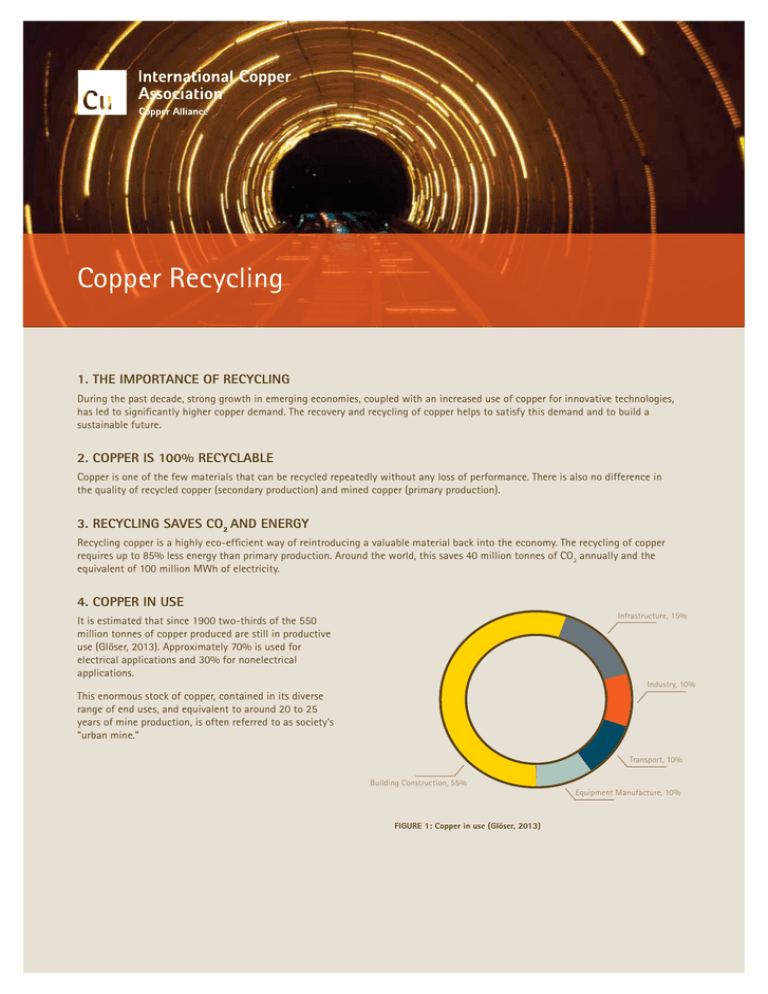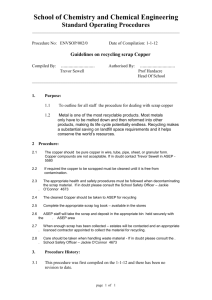
Copper Recycling
1. THE IMPORTANCE OF RECYCLING
During the past decade, strong growth in emerging economies, coupled with an increased use of copper for innovative technologies,
has led to significantly higher copper demand. The recovery and recycling of copper helps to satisfy this demand and to build a
sustainable future.
2. COPPER IS 100% RECYCLABLE
Copper is one of the few materials that can be recycled repeatedly without any loss of performance. There is also no difference in
the quality of recycled copper (secondary production) and mined copper (primary production).
3. RECYCLING SAVES CO2 AND ENERGY
Recycling copper is a highly eco-efficient way of reintroducing a valuable material back into the economy. The recycling of copper
requires up to 85% less energy than primary production. Around the world, this saves 40 million tonnes of CO2 annually and the
equivalent of 100 million MWh of electricity.
4. COPPER IN USE
Infrastructure, 15%
It is estimated that since 1900 two-thirds of the 550
million tonnes of copper produced are still in productive
use (Glöser, 2013). Approximately 70% is used for
electrical applications and 30% for nonelectrical
applications.
Industry, 10%
This enormous stock of copper, contained in its diverse
range of end uses, and equivalent to around 20 to 25
years of mine production, is often referred to as society’s
“urban mine.”
Transport, 10%
Building Construction, 55%
Equipment Manufacture, 10%
FIGURE 1: Copper in use (Glöser, 2013)
5. COPPER, THE RECYCLING CHAMPION
Currently, a total of around 9 million tonnes of copper per year come from the recycling of “old” scrap (copper contained in
end-of-life products) and “new” scrap (generated during production and downstream manufacturing processes). The figure below
shows how recycling is a core part of the overall copper value chain.
Copper recycling includes material collected from end-of-life products such as
cables and wires, electric hardware, as well as the remelting of factory waste.
COPPER,
THE RECYCLING
CHAMPION
CONSUMER
SCRAP
Approx. 24 million
tonnes of copper were
used globally in 2010;
35 percent of this was
sourced through recycling.
SCRAP
DEALERS
5 million
tonnes
MINING
PRODUCTION
& RECYCLING
16 million tonnes
SEMI-FABRICATED
PRODUCTS:
pipes, sections, sheets, wires
Some semi-fabricated copper
products are manufactured entirely
from recycling.
Take-back
schemes, and
collection
CAR
HOUSE
50 KILOS
100 KILOS
PRODUCTS
COMPUTER
WINDMILL
1.5 KILOS
5,000 KILOS
4 million tonnes
COPPER IS 100% RECYCLABLE: unlike most other
FACTORY
SCRAP
Source: Glöser, 2013
materials, it can be perpetually recycled without loss of
performance or qualities. Recycled copper is identical to
mined copper.
FIGURE 2: Simplified value chain for copper
While a few copper applications result in unrecoverable losses, such as dissipative losses due to abrasion (e.g. automotive brake pads)
and copper chemicals used as animal food supplements and fungicides, most other applications are part of well-established recovery
and take-back schemes.
6. HISTORICAL PERSPECTIVE
Two of the most relevant indicators of the recycling performance of copper are the Recycling Input Rate, which tracks the percentage
of annual copper use sourced through recycling, and the End-of-Life Recycling Rate, which represents the amount actually recycled
as a percentage of what is theoretically available in a given year. Both indicators have remained fairly stable since the 1950s, despite
the steady increase in annual copper demand (from 2.5 million tonnes in 1950 to 19 million tonnes today) and the increasing
complexity of the many end-use products containing copper, e.g., cell phones and laptops, which are more difficult to collect
and reprocess.
60%
40%
20%
0%
1950s
1960s
1970s
1980s
End-of-Life Recycling Rate
1990s
2000s
2010
Recycling Input Rate
2011
FIGURE 3:
Copper recycling rates since 1950 (Glöser, 2013)
7. COPPER FLOW MODEL
A comprehensive study of the stocks, flows and recycling rates for copper has been developed by the Fraunhofer Institute. This complex,
three-year study has resulted in a much improved understanding of how copper is used and re-used by society.
Smelting and refining / SXEW
Global
mining
Total refined copper
16,250 kt (a)
3,800 kt
Semi-finished goods production
19,700 kt
350 kt (b)
Low grade
copper scrap
for smelting
and refining
25,150 kt
Permanent losses during smelting
(including around 100 kilo tonnes of losses
during scrap smelting and refining)
150 kt (b)
5,600 kt
Directly melted high grade copper scrap
4,200 (j), (k)
Scrap from fabrication
2,300 kt (h)
Losses during
separation
5,200 kt (i)
Collected and separated EoL Scrap
7,500 kt (g)
Permanent
losses during
semis production
Fabrication
of end-use
products
200 kt (b)
Permanent losses
during fabrication
450 kt (d)
Dissipation/
3,600 kt (f)
Losses during Abandoned in place
scrap collection
11,100 kt (e)
Total copper content
in EoL Scrap
STOCKS
IN USE
20,750 kt (c)
Global copper in use:
360,000 kt
FIGURE 4: Global copper stocks and flows 2010 (Glöser, 2013)
8. RECYCLING RATES
Based on the work of the Fraunhofer Institute, the following global recycling rates for copper can be derived.
Recycling Rate (2011)
Value (%)**
End-of-Life (EoL) Collection Rate
Definition*
EoL RR = ei
EoL CR = ge
End-of-Life (EoL) Processing Rate
EoL PR = gi
70%
Overall Recycling Efficiency Rate
ORER = i + k
e+j
i
k
RIR = a ++i +
k
60%
End-of-Life (EoL) Recycling Rate
Recycling Input Rate
45%
65%
35%
TABLE 1:
Copper recycling rates (Glöser, 2013)
* The recycling rates are those developed by Eurometaux and Eurofer (Eurometaux, 2012).
** These rounded values are derived from the simplified and rounded flows of Figure 4. They can be slightly different from the real values
generated by the full model.
9. SUMMARY
Copper is one of the few materials that can be recycled repeatedly without any loss of performance. As well as helping to satisfy the
annual demand for copper, recycling conserves valuable natural resources, saves energy and reduces CO2 emissions.
The growing demand for copper will require a combination of raw materials coming from mines (primary copper), as well as from
recycled materials (secondary copper). During the last decade about 35 percent of annual copper use came from recycled sources.
Nevertheless, for recycling to be effective, innovation is also needed. Endeavors supporting recycling can be implemented in new
product design to facilitate end of life recovery and the industrial recycling processes to increase overall yields. In addition, regulatory
policies must continue to encourage recovery and recycling, both at the industry level and by the individual citizen.
10. DISCLAIMER
This document, developed to provide information on copper recycling, has been prepared from publically available information.
Its purpose is to provide readers with information to make independent business decisions.
11. ANNEX: REFERENCES
Glöser, Simon; Soulier, Marcel; Tercero Espinoza, Luis A. (2013): A dynamic analysis of global copper flows. Global stocks,
postconsumer material flows, recycling indicators & uncertainty evaluation. In Environ. Sci. Technol. (in press) DOI: 10.1021/es400069b.
http://pubs.acs.org/doi/abs/10.1021/es400069b
Recycling Rates for Metals (Eurometaux and Eurofer, 2012). http://www.eurometaux.org/Publications/BrochuresandLeaflets.aspx
International Wrought Copper Council (IWCC, 2013). http://www.coppercouncil.org/
World Copper Factbook (ICSG, 2013). http://www.icsg.org/index.php/component/jdownloads/finish/170/1188
260 Madison Avenue, New York, NY 10016 USA
Phone: (212) 251-7240, Fax: (212) 251-7245
copperalliance.org, info@copperalliance.org
© Copyright 2014 International Copper Association, Ltd. | Copper Alliance™ is a trademark of the International Copper Association, Ltd. All Rights Reserved. | 5/19/14-ICA-BR-GL-HE-03-EN




